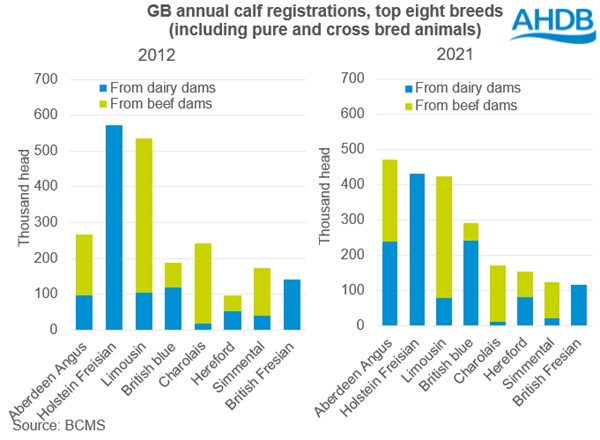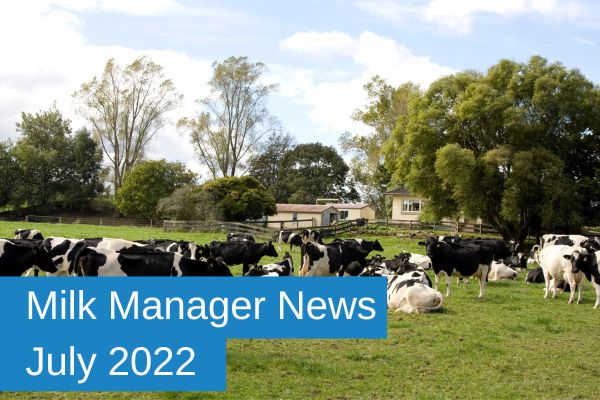Milk Manager News July 2022 – Maximising Beef from the Dairy Herd
1 July 2022It is perhaps not surprising that dairy semen sales are at a 17 year low and registered births of beef bred calves from the dairy are at a 10 year high. Beef calves out of the dairy herd are becoming increasingly valuable, and sexed semen is being used to more effect for quicker genetic improvement by targeting heifers and the best cows to breed dairy replacements.
This leaves anywhere between 65 – 75% of the herd free to run with a beef bull or be inseminated with beef semen. Many dairy producers look for an easy calving, short gestation length bull, but there also needs to be an eye kept on traits that push daily live weight gain, days to slaughter and muscle depth. The graph below shows Limousin, Charolais and Simmental calf registrations have all stayed the same, if not decreased, but there has been a huge rise in Aberdeen Angus, British Blue and Hereford sires being used. With Aberdeen Angus, Shorthorn and Hereford premiums offered then it is easy to see why these breeds are rising to meet market demand.
With the ability to produce an even more consistant product, processors are looking to beef sired calves from the dairy herd to fill contracts, Dairy registered animals that once used to make up 13% prime beef, are now closer to 8%. Furthermore, 25% of beef registered calves were born to dairy dams 10 years ago, but by 2019 this had reached 33% and in 2021 was 37%. This again shows the rising influence of dairy crossed beef calves on British beef production.
With increased costs of production dairy farmers do not want the additional cost of keeping livestock they do not need on the farm, so having a contract to get rid of beef bred calves not only lessens the workload but improves cash flow and brings another form of money into the business regularly. For dairy farmers who have land, sheds and labour available, then finishing their own beef bred cattle is a valuable income.
As with dairy replacements, beef bred calves need a high standard of management for success of the enterprise. It is very important to put protocols in place that will allow your beef calves to meet target performance and the key focus areas are:
- Colostrum quality, feeding and management
- Determining successful passive transfer of antibodies from colostrum
- Animal nutrition
- Animal health
- Growth performance
What to consider when finishing your own beef bred cattle:
- What the customer wants and when the product is required. Note that some customers do not buy bulls.
- Availability of housing. Is it secure enough for a group of bulls or heifers? Any new livestock building must be designed specifically for livestock and not as a general-purpose building, as these often have an insufficient ridge opening to ensure adequate ventilation. It is important that buildings have good drainage. Consider if there is enough room for groups of cattle to grow together without the need for mixing.
- Availability and cost of straw or other materials for bedding. Different classes and ages of stock require different amounts of straw. When calculating straw requirements, also consider the amount needed for feed. If you need to buy in a proportion of your straw requirements, consider how price fluctuations could affect your business. Over the last five years, straw prices have fluctuated from £30/t to £100/t.
- What home-grown feeds and forages are available? What quality are they? Do you have enough surplus to feed extra cattle?
- Availability and cost of bought-in feeds.
calum.smith@sac.co.uk; 07736 131276
Sign up to the FAS newsletter
Receive updates on news, events and publications from Scotland’s Farm Advisory Service


